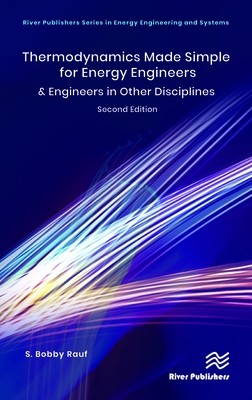
- We will send in 10–14 business days.
- Author: S Bobby Rauf
- Publisher: River Publishers
- ISBN-10: 8770223491
- ISBN-13: 9788770223492
- Format: 15.6 x 23.4 x 2.2 cm, kieti viršeliai
- Language: English
- SAVE -10% with code: EXTRA
Reviews
Description
This book provides an overview of the important principles, concepts and analytical techniques pertaining to thermodynamics, written in a way that makes this abstract and complex subject relatively easy to comprehend.
Thermodynamics topics such as enthalpy, entropy, latent heat, sensible heat, heat of fusion, and heat of sublimation are explained and illustrated in detail. Also covered are phases of substances, the law of conservation of energy, Steady Flow Energy Equation (SFEE), the first and second laws of thermodynamics, ideal gas laws, and pertinent formulas. The author also examines various thermodynamic processes, as well as heat and power cycles such as Rankine and Carnot. Case studies are used to illustrate various thermodynamics principles, and each chapter concludes with a list of questions or problems for self-assessment, with answers provided at the end of the book.
Written specifically for engineers, professionals with science and math backgrounds, energy professionals, and technicians the content is presented in a way which also allows many non-engineering professionals to follow the material and glean useful knowledge. For energy engineers who have been away from direct engineering practice for a while, this book will serve as a quick and effective refresher.
EXTRA 10 % discount with code: EXTRA
The promotion ends in 22d.00:42:51
The discount code is valid when purchasing from 10 €. Discounts do not stack.
- Author: S Bobby Rauf
- Publisher: River Publishers
- ISBN-10: 8770223491
- ISBN-13: 9788770223492
- Format: 15.6 x 23.4 x 2.2 cm, kieti viršeliai
- Language: English English
This book provides an overview of the important principles, concepts and analytical techniques pertaining to thermodynamics, written in a way that makes this abstract and complex subject relatively easy to comprehend.
Thermodynamics topics such as enthalpy, entropy, latent heat, sensible heat, heat of fusion, and heat of sublimation are explained and illustrated in detail. Also covered are phases of substances, the law of conservation of energy, Steady Flow Energy Equation (SFEE), the first and second laws of thermodynamics, ideal gas laws, and pertinent formulas. The author also examines various thermodynamic processes, as well as heat and power cycles such as Rankine and Carnot. Case studies are used to illustrate various thermodynamics principles, and each chapter concludes with a list of questions or problems for self-assessment, with answers provided at the end of the book.
Written specifically for engineers, professionals with science and math backgrounds, energy professionals, and technicians the content is presented in a way which also allows many non-engineering professionals to follow the material and glean useful knowledge. For energy engineers who have been away from direct engineering practice for a while, this book will serve as a quick and effective refresher.


Reviews